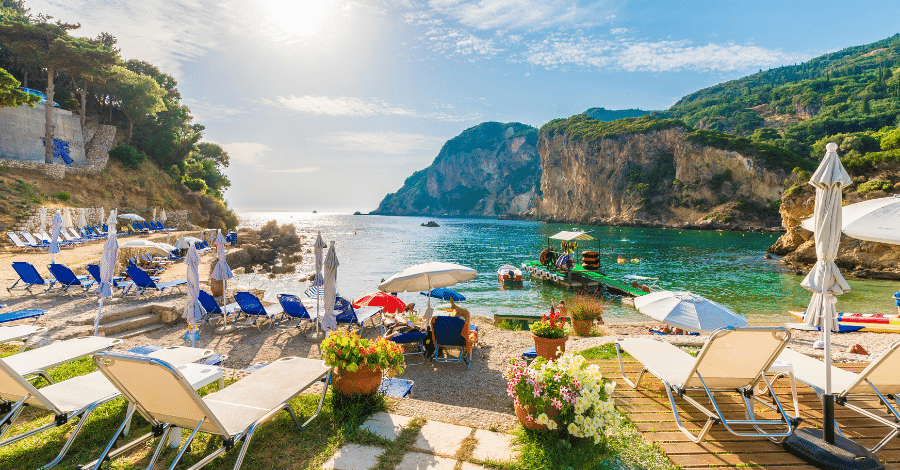Many Americans and British citizens who have made the move to Greece love their lives in this gorgeous country because everyone is warm and friendly. Traditionally, most foreigners moving to Greece have chosen city life in either Athens, Thessaloniki or Patras. Until recently, this made sense because they found a more sophisticated infrastructure in the cities.
However, in recent years things are changing and the Greek islands have been getting more attention not just for tourism, but for long term living. With increasing development and modernizing, today many Greek islands offer easier living and because of this, they are becoming a more popular choice for expats. For those who seek peace, solitude and unity with nature, the beautiful Greek islands are certainly a better choice than city life.
The idea of living on a Greek island certainly sounds both romantic and appealing. But how do you choose the best ones when there are 6,000 Greek islands and islets and 227 of them are inhabited?
We have researched and gathered information from expats who call Greece home to bring you five of the best Greek islands to live on.
1. Corfu (also known as Kerkyra)
- Location: Corfu is situated in the Ionian Islands, off the west coast of Greece
- Size: 610 km² (235 square miles)
- Population: 100,000
- Main attractions: Fantastic historical monuments, good scuba diving and other water sports, horse riding and an 18-hole golf course
Corfu is a popular island and has more expats than any other Greek island. Corfu is a lush green island with beautiful beaches and a rich history that can be explored, including the two Venetian fortresses that overlook its capital, a French arcade and numerous elegant mansions.

Its capital – Corfu Town – is impressive with cobbled streets and interesting architecture and appears on the UNESCO World Heritage List. There are numerous historical and religious monuments to visit. In fact, there are numerous interesting things to do in Corfu, as this is one of the most animated islands in Greece.
Corfu has plenty of life all year round and a distinctive Italian character as it was ruled by the Venetians for 400 years (1386 – 1797). In addition to many traditional Italian dishes on local menus, you are able to order a Limoncello as easily as an Ouzo.
There is great swimming and snorkelling on Corfu Island, with the Blue Lagoon being the best location. If you’re looking to explore beyond the island, there are numerous boat trips to other islands including Paxos and Anti Paxos.

The Greek mainland and Albania are both within easy reach. Corfu airport and port are both situated in the main town making travel extremely easy.
Corfu has a strong farming tradition which means there is an abundant supply of fresh fruit, vegetables, as well as local cheeses and olive oil in the shops and markets. There are numerous pretty villages to discover too, including Pelekas and Kassiopi.
2. Crete
- Location: 160 km (100 mi) south of mainland Greece, in the Aegean Sea
- Size: 8,450 km² (3262 square miles) – the 5th largest island in the Mediterranean
- Population: 630,000
- Main attractions: Archaeology, history, hiking, scuba diving and other water sports, horse riding and an 18-hole golf course at Hersonisos
Crete is the largest and oldest of the Greek islands, and was once home to the ancient Minoan civilization who lived in the magnificent Palace of Knossos. The island is one of the warmest places in Europe, and so it is ideal for those in search of warm winters and lots of sun.

One of the island’s best assets is its diverse landscape. Crete has barren mountains, deep gorges and a coastline that is dotted with pretty sandy beaches – including Elafonisi and Balos with their pale pink sand. There are areas with impressive cliffs and many small fishing harbors.

This island has a strong community spirit in its towns and villages, almost zero crime rate and a really good medical infrastructure. Its main towns include Heraklion – its capital – Elounda, Chania and Rethymnon. Given its size and natural diversity, you will never run out of things to do in Crete. If you are into a more active lifestyle, this island is for you.
Crete is one of the best Greek islands to live as it has a rich culture and traditions, numerous festivals and one of the healthiest diets in the world. Important to note that the Cretan economy is not wholly dependent on tourism and prices are lower than on other islands.

In recent years, Crete has become home to many expats from all over Europe and the United States and the town of Elounda has a particularly strong expat community.
3. Santorini (also known as Thira)
- Location: One of the Cyclades islands 200 km (124 mi) southeast of Athens
- Size: 90 km² (35 square miles)
- Population: 15,500 permanent residents, plus 2 million visitors
- Main attractions: water sports, cycling, walking and horse riding along the beach
Said to be the most beautiful island of all, Santorini was formed by a volcanic eruption during the 16th century BC, which left part of the volcanic crater and a now submerged crater known as the Caldera.

Its capital, Thira, clings to the top of the cliffs of the Caldera and is postcard pretty with cubic whitewashed houses and churches with bright blue domes. Many of the winding narrow streets of the capital are pedestrian and a number of the island’s beaches comprise of black and red volcanic sand and pebbles.
There is a spectacular walk around the rim of the Caldera to the village of Oia, where there the most amazing sunsets can be enjoyed. The nightlife in both towns is colorful and fun in season.
During the summer months, the island does get really busy, but by October, all the visitors have left and the island is remarkably peaceful. Away from Thira and the beach resorts of Kamari and Perivolos, the smaller villages remain quiet even in the summer months.

The island is well known for its wineries and it also has a brewery. For those interested in mythology, it is thought that Santorini could be the lost kingdom of Atlantis. Because Santorini is a tourist hot spot like Mykonos, prices do tend to be generally higher.
The island has its own airport with flights to most European countries during the summer months. There are also numerous boat trips both around the Caldera and to its hot sulphur springs, plus the chance to enjoy some island-hopping. Catamaran cruises are among the most sought-after activities on Santorini, as the island looks spectacular when admired from the sea.
For gorgeous panoramic views – if you don’t mind the great influx of tourists each summer, Santorini is one of the best Greek islands to live.
4. Paros
- Location: Paros is in the center of the Cyclades group, about 150 km (93 mi) southeast of the port of Piraeus
- Size: 165 km² (64 square miles)
- Population: 12,000
- Main attractions: Boat trips to Antiparos, Mykonos and Santorini and private boat hire, plus cycle rides, hiking and water sports, especially wind surfing
During the past few years, Paros has started to attract foreigners seeking a new home on a beautiful and quieter Greek island where time is marked by the passing seasons. Paros has variable and impressive landscapes and numerous lovely beaches with crystal clear waters.

Paros has long been famous for its top-quality marble, which is snowy white and translucent. Sculptors used the marble to create some of the world’s most famous statues including Hermes by Praxiteles, Venus de Milo and Nike of Samothrace while also being incorporated in many grand buildings. The island is well known for coaxing the creative spirit in residents and over the centuries has been famous for its sculptors, artists and poets.
Parikia is the island’s capital town, overlooking a pretty bay, which is the boat trip hub for all the Cycladic islands. Parikia has a good and varied night life with something for everyone.

There are pretty villages on the island to visit, including Naousa, a fishing village on its north-eastern corner and Kolimbithres where there are a series of delightful rocky swimming coves.
Like many of the smaller islands, Paros is very quiet during the winter months as many of the islanders tend to move to the mainland to spend this time of the year. Paros is very accessible, it can be reached by boat from Piraeus and in 2016, its airport was completely modernized.
5. Spetses
- Location: Located in the Saronic Gulf, Spetses is just 101 km (63 mi) from Athens
- Size: 27 km² (10 square miles)
- Population: 3,600
- Main attractions: Island-hopping with the hydro foil to Hydra or Porto Heli, the open air cinema, hiking and horseback riding
If a car-free island where you can explore on foot in a single day appeals to you, Spetses is the best Greek island to live. Located in the heart of the Saronic group of islands, the nearest airport to Spetses is Athens, followed by a three-hour ferry crossing from Piraeus.

Once you arrive in Spetses, you will be enchanted by its beauty and unique character. During the 18th century it was a strong naval power. Testament to this are the numerous grand Captains’ mansions dotted along its shores. Spetses has numerous lovely beaches, including some small, hidden ones.
Its smaller size and fewer number of inhabitants means that local prices are slightly higher across the board. For those who enjoy walking, the island walk is fun, but for those who prefer doing things in style can opt for a horse-drawn carriage.

Because of its close proximity to Athens, Spetses has long attracted the rich and the famous during the summer months. Once autumn turns to winter, many of its inhabitants head to the mainland, which is an important point to consider if you do not want to do the same. Healthcare is another important consideration as facilities are limited on the island, as the main medical care is in Athens.

Greece is one of the safest countries in the world. As such, choosing to live on a Greek island can be really fantastic, safe and life-changing, as long as you thoroughly research of the best Greek islands to live and make the choice that suits you best.
Also keep in mind that there are some drawbacks to living on an island. It is important to remember that island life is at a much slower pace and that often if there is a problem, for example with the electricity, it could take several days to resolve.
The Greeks love fresh food and rarely buy anything canned or frozen as they enjoy each locally grown fruit and vegetable for the time it is in season, even if it does mean eating too many apricots and cherries in May or watermelon in August. The chances are that if you are walking past a table of Greeks enjoying the seasonal fruit you will be invited to pull up a chair with the word Kalosorisate – come share with us.

